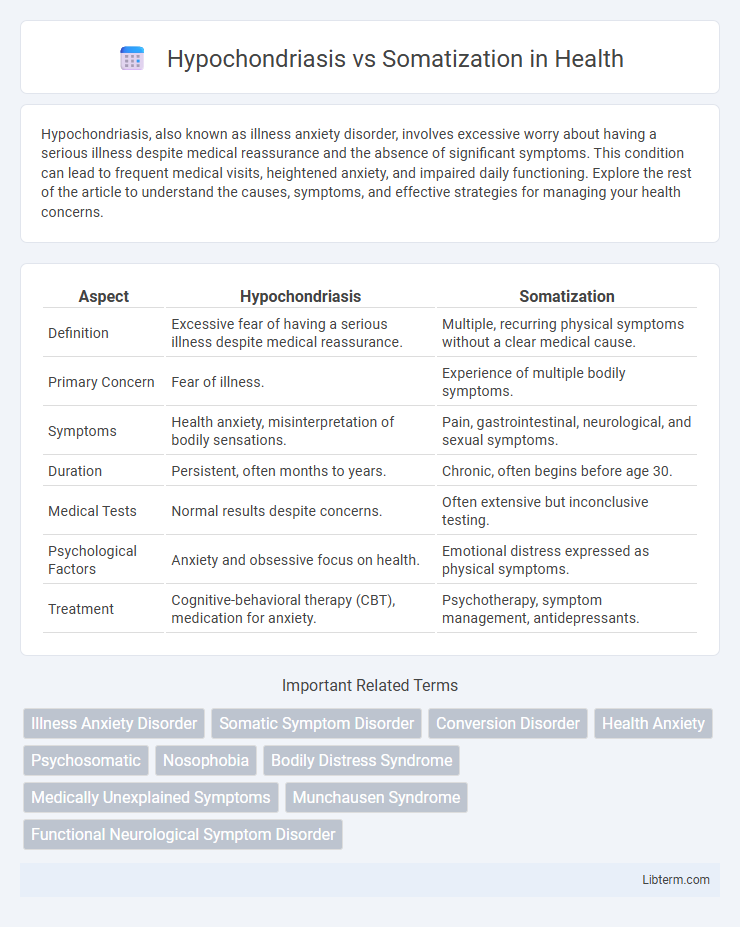Hypochondriasis, also known as illness anxiety disorder, involves excessive worry about having a serious illness despite medical reassurance and the absence of significant symptoms. This condition can lead to frequent medical visits, heightened anxiety, and impaired daily functioning. Explore the rest of the article to understand the causes, symptoms, and effective strategies for managing your health concerns.
Table of Comparison
| Aspect | Hypochondriasis | Somatization |
|---|---|---|
| Definition | Excessive fear of having a serious illness despite medical reassurance. | Multiple, recurring physical symptoms without a clear medical cause. |
| Primary Concern | Fear of illness. | Experience of multiple bodily symptoms. |
| Symptoms | Health anxiety, misinterpretation of bodily sensations. | Pain, gastrointestinal, neurological, and sexual symptoms. |
| Duration | Persistent, often months to years. | Chronic, often begins before age 30. |
| Medical Tests | Normal results despite concerns. | Often extensive but inconclusive testing. |
| Psychological Factors | Anxiety and obsessive focus on health. | Emotional distress expressed as physical symptoms. |
| Treatment | Cognitive-behavioral therapy (CBT), medication for anxiety. | Psychotherapy, symptom management, antidepressants. |
Introduction to Hypochondriasis and Somatization
Hypochondriasis, also known as illness anxiety disorder, is characterized by an excessive preoccupation with having a serious illness despite medical reassurance. Somatization involves multiple, recurring physical symptoms without a clear medical cause, reflecting psychological distress. Both conditions highlight the complex interplay between mind and body in expressing health-related anxieties.
Defining Hypochondriasis: Symptoms and Characteristics
Hypochondriasis, now often referred to as illness anxiety disorder, is characterized by excessive worry about having a serious illness despite medical reassurance and absence of significant symptoms. Key symptoms include preoccupation with bodily sensations, frequent health-related anxiety, and persistent fear that minor or normal physical sensations indicate a severe disease. Unlike somatization disorder, which involves multiple unexplained physical symptoms across different organ systems, hypochondriasis centers on anxiety about illness rather than the symptoms themselves.
Understanding Somatization: Core Features
Somatization involves the experience of multiple, chronic physical symptoms that lack a clear medical cause, often leading to significant distress and functional impairment. Core features include persistent bodily complaints such as pain, gastrointestinal issues, and neurological symptoms, which cannot be fully explained by medical conditions but are linked to psychological factors. Unlike hypochondriasis, which centers on excessive worry about having a serious illness, somatization emphasizes the manifestation of physical symptoms driven by psychological distress.
Key Differences Between Hypochondriasis and Somatization
Hypochondriasis primarily involves excessive fear or belief of having a serious illness despite medical reassurance, whereas somatization features multiple, recurrent physical symptoms without a clear medical cause. Unlike hypochondriasis, somatization often presents with varied bodily complaints affecting different organ systems and is typically chronic. Both conditions impact daily functioning, but hypochondriasis centers on health anxiety, while somatization reflects a broader pattern of medically unexplained symptoms.
Psychological Factors Influencing Each Disorder
Hypochondriasis involves excessive preoccupation with having a serious illness despite medical reassurance, driven by heightened health anxiety and catastrophic misinterpretation of bodily sensations. Somatization disorder presents as multiple, medically unexplained physical symptoms influenced by psychological distress, emotional conflict, and a tendency to express mental pain through the body. Both disorders are shaped by cognitive biases, coping styles, and underlying anxiety or depressive disorders, but hypochondriasis centers on illness fear while somatization reflects broader emotional dysregulation.
Diagnostic Criteria: DSM-5 Comparisons
Hypochondriasis, now classified as Illness Anxiety Disorder in the DSM-5, is characterized by excessive worry about having or acquiring a serious illness despite minimal or no somatic symptoms. Somatization Disorder, replaced by Somatic Symptom Disorder, involves multiple, recurrent, and clinically significant somatic complaints causing distress or impairment, with disproportionate thoughts, feelings, or behaviors related to these symptoms. The key diagnostic distinction lies in Hypochondriasis focusing on health anxiety without substantial symptoms, whereas Somatization emphasizes actual physical symptoms with psychological distress.
Overlapping Symptoms and Differential Diagnosis
Hypochondriasis and somatization share overlapping symptoms such as persistent preoccupation with health concerns and multiple physical complaints without identifiable medical causes. Differential diagnosis involves assessing symptom focus; hypochondriasis centers on fear of specific illnesses, whereas somatization includes diverse bodily symptoms affecting various organ systems. Diagnostic criteria from DSM-5 emphasize the intensity and nature of health anxiety in hypochondriasis compared to the broader symptom presentation in somatization disorder.
Impact on Daily Life and Functioning
Hypochondriasis often leads to excessive health-related anxiety, resulting in frequent medical visits and persistent worry that disrupt daily activities and social functioning. Somatization involves multiple, chronic physical symptoms without a clear medical cause, causing significant impairment in occupational performance and interpersonal relationships. Both disorders can severely reduce quality of life by fostering ongoing distress and functional limitations.
Treatment Approaches for Hypochondriasis and Somatization
Treatment approaches for hypochondriasis primarily involve cognitive-behavioral therapy (CBT) aimed at reducing health anxiety through cognitive restructuring and exposure to feared symptoms. Somatization disorder treatment often combines psychotherapy, particularly CBT, with pharmacotherapy such as antidepressants to address underlying mood disturbances and improve symptom management. Both conditions benefit from a multidisciplinary approach, including regular medical follow-ups to prevent excessive healthcare utilization and reinforce therapeutic progress.
Coping Strategies and Support Resources
Effective coping strategies for hypochondriasis emphasize cognitive-behavioral therapy (CBT) to address health anxiety, incorporating mindfulness techniques to reduce intrusive health-related thoughts. Somatization management often involves a multidisciplinary approach, including psychotherapy, stress management, and physical therapy to alleviate multiple unexplained symptoms. Support resources such as patient education programs, support groups, and collaboration with healthcare providers play a critical role in improving patient outcomes for both conditions.
Hypochondriasis Infographic

 libterm.com
libterm.com